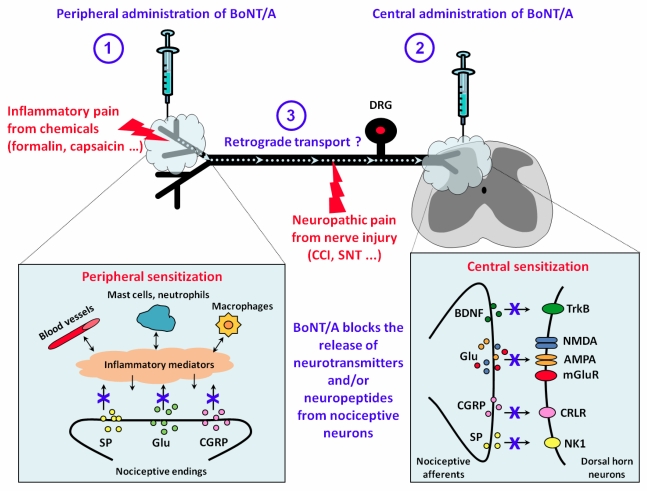Figure 3.
Proposed mechanism of action of BoNT/A in pain modulation. In this scheme, the analgesic effects of BoNT/A is thought to be exerted through the inhibition of the release of neurotrasmitters and/or neuropeptides from nociceptive neurons both at peripheral and/or central level, depending on the route of administration. (1) The peripheral analgesic effect of BoNT/A, as observed after subcutaneous or intraplantar injection, may be a direct consequence of the reduced release of neuromodulators from nociceptive endings. By inhibiting this release, peripherally injected BoNT/A may reduce directly the peripheral sensitization. (2) When intrathecally injected, BoNT/A may inhibit the release of neurotransmitters and/or neuropeptides from central terminals of nociceptive afferents reducing the central sensitization. (3) Central analgesic effects may be also induced by retrograde transport along axons of peripherally injected BoNT/A. These peripheral and central effects may occur, and partially overlap between them, both in inflammatory and neuropathic pain models. Symbols: AMPA, 2-amino-3-(5-methyl-3-oxo-1,2-oxazol-4-yl) propanoic acid receptors of glutamate; BDNF, brain derived neutrophic factor; CCI, chronic constriction injury; CGRP, calcitonin gene related protein; CRLR, calcitonin-receptor like receptor; DRG, dorsal root ganglions; Glu, glutamate; mGluR, metabotropic glutamate receptors; NK1, neurokinin 1 receptors; NMDA, N-methyl-D-Aspartate receptors of gluatamate; SNT, spinal nerve transection; SP, substance P; TrkB, tyrosin kinase B receptors.

